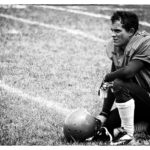Let’s face it. Despite all the rage about “fail fast and fail forward” in Silicon Valley, one fact is undeniable: Failure sucks. It’s painful. It’s embarrassing. When it happens, you want to get into the fetal position and hide underneath your blankets.
Failure is also ubiquitous. Even top performers—people we tend to put on a pedestal—got to where they are after failing, failing, and failing some more. Behind the glamour is the type of messy and imperfect reality that confronts us all.
On the Famous Failures podcast, I interview the world’s most interesting people about the failures they’ve had in their lives and what they learned from them. Based on these interviews, I’ve culled together five strategies that top performers use to cope with failure. As Rocky Balboa said, “Life is not about how hard you hit. It’s about how hard you can get hit and keep moving forward.”
When you inevitably get hit, try one (or more) of these tactics to keep moving forward.
1. Isaac Lidsky: Quieting your inner critic
Isaac Lidsky is an entrepreneur, bestselling author, and coveted speaker. He was a child television star, appearing as series regular “Weasel” on NBC’s “Saved By The Bell: The New Class.” He left his acting career and went on to graduate from Harvard at 19 with an honors degree in mathematics and computer science. He returned to Harvard to study law and became the only blind person to clerk on the U.S. Supreme Court (for Justices Sandra Day O’Connor and Ruth Bader Ginsburg).
Isaac was born with Retinitis Pigmentosa, a rare degenerative disease of the retina. From age 12 to 25, he slowly lost his sight. Using insights from his experiences, he authored the New York Times bestseller, Eyes Wide Open.
Here’s how Isaac copes with the debilitating inner critic that lives inside of our heads:
When I think about our fear of failure and ongoing struggle in the face of big challenges, I think about Teddy Roosevelt’s brilliant remarks about the critic and the strong man. To my mind, Roosevelt’s critic embodies our fear of failure, a very pernicious force, this nasty voice in our mind that tells us what we can’t do. It tells us what other people are going to think and say about us, and it can be really debilitating.
If you listen to the critic in your mind long enough and if you’re not careful, you will believe him. Then the criticism becomes self-fulfilling. Once you believe him, it brings about the result you hoped to avoid in the first instance.
Think about someone who’s a dancer, let’s say, who loves their craft and finds joy in it, but is so terrified of the nasty reviews of both that internal critic and external critics, that it keeps them off the stage. They lose the joy in dancing and stop doing it altogether. To me, that’s the allegorical heart-breaking example of this dynamic at work.
Taking control of your reality is understanding that these nasty messages you’re getting from yourself, and this barrage of cues you’re getting from what you see around you about what success should look like and what you should be doing, are really just noise. They don’t need to govern your life, your behavior, or your decisions, unless you choose to let them do so.
I think fundamentally it is all choice. We choose in every single moment how we want to live our lives and who we want to be.
2. Adam Grant: Mindset and Time Travel
Adam Grant is an organizational psychologist, the top-rated professor at Wharton, a coveted speaker, and a prolific author. He is a leading expert on how we can find motivation and meaning, and live more generous and creative lives. He’s the host of the new WorkLife podcast.
Here’s how Adam copes with failure:
I think there’s a battle between two reactions [to failure]. One is the defensive, self-protective, “this is something that I never want to experience again so I’m not going to try anything hard, or new, again.” The other is the curious, the pro-active, the gritty, the learning-oriented, fill-in-your-blank set of reactions.
What I try to do is choose the latter. It’s easier to do that now, knowing that I’ve been through it a bunch of times. I don’t start out with confidence that I’m a good teacher, a good writer, or a good researcher. But I do have confidence that I’m good at learning things and I’m motivated to get better.
In the long run, the person I want to be is the person who says, “I didn’t give up at something I might have been able to improve at, and eventually excel at.”
Mental time travel is also helpful. Zooming out, I know that next month, this failure is not going to sting as much as it does today. In a year, I might have even forgotten it, if I look at my past experience. So in the long run, how will I want to have reacted? It’s like stepping on the accelerator of the learning reaction.
3. Daniel Pink: Mean Reversion
Daniel Pink is the author of seven groundbreaking books, including the #1 New York Times bestsellers, A Whole New Mind and Drive. His newest book, When: The Scientific Secrets of Perfect Timing, was published in January 2018 and became an instant New York Times bestseller. Here’s how Dan uses mean reversion to deal with failure:
This is going to sound ridiculously hyper-rational, but it’s truthful: I believe in mean reversion. Things will go up and things go down, but ultimately everything reverts to the mean. If you have some things that are working really well, at some point something’s not going to work well. If you have things that are not working very well, at some point, something’s going to work well.
As a consequence, I try not to get too disappointed when things go south. And if something goes well, I feel better than if it doesn’t go well, but it’s not as if I’m celebrating and feeling a sense of euphoria. It’s more like, “Okay, that’s good. I’m glad.” Then I move on.
With mean reversion, you don’t get too bummed out by the lows and you don’t get too pumped up by the highs. You just do the best work you can in every circumstance. You focus on the work rather than on how the outcome of the work makes you feel.
4. Bea Arthur: Just do it
A child of entrepreneurs, Bea Arthur has used her tenacity and creativity to become a successful therapist, entrepreneur, and media personality. As a celebrated woman in tech, she’s been a TedX speaker, Forbes writer, and the first black woman admitted to Y Combinator, the world’s most prestigious start-up incubator. Here’s how Bea finds the motivation to move forward in the face of failure:
My family is from Ghana in West Africa. Both of my parents are entrepreneurs. My older sister is an entrepreneur. Africa is the perfect place for the startup mindset because there’s very little infrastructure and the idea of starting something and it being orderly just isn’t as big. If I walked into a bureau and said, “Here’s my application for an LLC,” that paper isn’t going anywhere. So, naturally, there’s a by-any-means-necessary kind of mindset. You do what you have to do to make it work.
I’ll say that I’m really blessed to have this fearlessness. I wasn’t scared because I didn’t know to be scared. Don’t do too much homework. Don’t listen to too many podcasts. Just do it. You can follow all the formulas you want, but the unique power of execution is in you and the way you do things. Be flexible and don’t be too bull-headed.
5. Gretchen Rubin: Find the fun in failure
Gretchen Rubin started her career in law—including clerking for Supreme Court Justice Sandra Day O’Connor—before stopping everything to become a writer. Though the transition was pitted with failure, it turned out to be one of the best decisions she made. Not only has she written three New York Times Bestsellers—Better Than Before, The Happiness Project, and Happier at Home—she’s also built an enormous readership, sold more than three million books, and started a popular weekly podcast called Happier with Gretchen Rubin.
This is a mantra that has really helped me: “Enjoy the fun of failure.” I think people sometimes have this feeling of shame when they fail. Like, they want to pretend it didn’t happen. So, enjoying the fun of failure is trying to recast failure in a more lighthearted way. Don’t try to ignore or re-categorize the failure—own it and have fun with it.
Failure is part of success—if you’re not failing, you’re not trying hard enough…not pushing the boundaries far enough. If I’m just doing everything the way I’ve always done it, and everything’s just kind of trickling along, that’s not a good sign.
Bold



